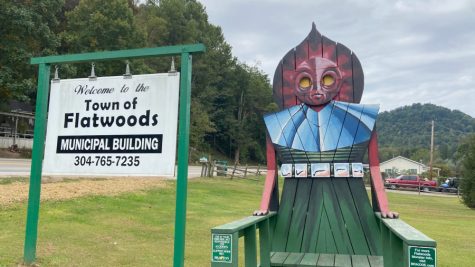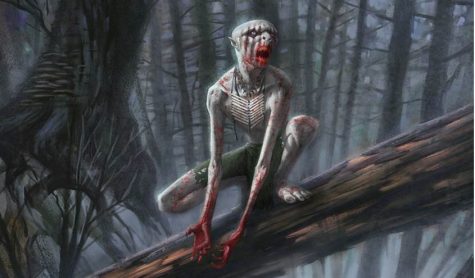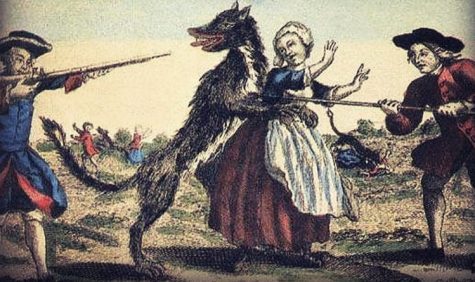Conspiracy Corner – Bridge Over Rough Water
Welcome back, trickers and treaters, to this week’s Conspiracy Corner, HALLOWEEN SPOOKTACULAR. The autumn season marks a time where the veil between worlds grows thinner. Normal and mundane interweaves with the strange and fantastical. Something about the season dredges up images of monsters in the woods, ghosts haunting the shadows, and all kinds of mysteries bubbling up to the surface. Yes, we here at Conspiracy Corner love Halloween and – in honor of the season – we wish to do something a bit special. To celebrate, I intend to write an article a little different than usual. Rather than one single case, I want to discuss an entire region that exhibits various kinds of odd phenomena. So, take a seat, unwrap your candy, and join me as we discuss the Bridgewater Triangle.
The Bridgewater Triangle is a geographical region in Massachusetts known for being a hotbed for supernatural, and just plain creepy activity. As you can tell from the name, this region makes the rough outline of a triangle. Freetown, Abington, and Rehoboth form the corners, while Bridgewater stands in the middle. If one is familiar with the history of Massachusetts, they may recall that this land was the site of King Philip’s War – one of the largest conflicts between Native Americans and European settlers. King Philip was the European-given name for Metacomet, leader of the Wampanoag tribe. He led a massive rebellion to push the colonizers from their land and this resulted in countless deaths. Atrocities, murders, and far worse were committed by both sides. The violence, blood, and hatred from that war seemed to soak into the very ground – scarring the land itself. Many believe this is the beginning of the Bridgewater Triangle; the land was cursed and has since attracted bizarre, terrible things like a lamp attract moths.
Consider the case of the missing Wampum Belt, and the curse supposed to come with it. For those unaware, a wampum belt was a belt made of white, seashell beads. They were primarily the tools of storytellers and leaders, having history, beliefs, and myths of the Algonquin peoples displayed via designs on the belts. To take such artifacts was seen as a great offense not just against the tribe, but their history and very existence. For that reason, it is believed that, when one such belt was taken off a murdered Native American general during the rebellion, a curse was laid across the land and would only be lifted when the belt is returned. Unfortunately, the belt has been lost to time. It seems that the curse if it is real, is here to stay.
Keep the idea of curses in the back of your mind as we discover the first of many incidents here: the case of Anawan Rock. Named for a chief that added King Philip in his eponymous war, Anawan Rock is the site of the Wampanoag tribe’s surrender to the English settlers. Since then, odd incidents have been reported there. People would claim to see great, massive bonfires in the distance, only for them to disappear as they drew closer. The beat of ominous drums would pound from everywhere and nowhere – signaling a call to a war that has been over for centuries. Other reports include silhouettes of Native American warriors preparing for war.
The next stop on our tour is another landmark with quite a few stories itself, the infamous Hockomock Swamp. Known to the Wampanoag tribe, as “the place where spirits dwelled”. Hockomock Swamp is the center of numerous stories. Tales of ghosts, spirits, and strange lights surround the area like mist. But a story we can confirm is a fact is that of an 8,000-year-old Native American burial ground where, according to excavators, remains would disappear moments after being uncovered. Stranger still, any photograph taken of the graves simply would not develop.
One particularly aggressive spirit one may spot while out in the woods is that of the Bridgewater Black Dog. A local man reported that, back in 1976, two of his prize ponies were found dead – their throats torn out. And standing over the corpses was a massive black dog. After the creature fled into the woods, the man decided wisely not to pursue it.
But not all strange things in the swamp are spectral. Hockomock is home to monsters entirely of flesh and blood – most chief among them being a strange cross of man and ape that prowls the bog. In 1970, reports of what witnesses describe as a “seven-foot Bigfoot-type creature”. It got to the point where the State Police launched a manhunt for a “bear”, though it turned up nothing.
The beast was seen again in 1978 by paranormal researcher, Joseph DeAndrade, who supposedly saw the creature while out on the swamp. He described feeling an odd chill before turning and witnessing the creature, tall and matted with brown fur, disappear into the woods. Reports of this Bigfoot (or “Massquatch”, as locals have named him) continue to this day.
One such sighting was in 1972 with one John Stanga. A child at the time, John and his friend Dave were exploring their neighborhood around 7:30 PM. It was a dark September night and as they walked along a dirt road to an open farm field, the only light was that of the school across the field. While they were hanging out, they spotted the outline of something against the bright lights, only thirty feet away. It was a large, dark figure standing about six to eight feet tall – with broad, muscular shoulders. Whatever it was, it had no neck, with its head only being a bump atop of the chest. John described it as like a gorilla in both stature and movement, supporting itself on its long arms.
It should be noted that was not the only strange thing John saw that night. He and his friend, naturally frightened by the appearance of an unknown, inhuman creature, fled the field. On their way home, they claimed to have seen a bizarre beam in the sky. He stated that, despite being bright purple, the beam did not illuminate the area. After that, John and his friend never saw anything odd in the woods again, leaving them – like us – with only questions that may go forever without answers.
Sasquatches are not the only man-like creature known to roam the swamp, though. This became terrifyingly clear to one Bill Russo, a man from the small town of Raynham, Massachusetts. He was out one night, having recently gotten home from his late shift at the local ironworks, when he decided to take his dog, Sammy, for a walk. Their walk took them along a path made for electrical poles known locally as the ‘High Tees’. As they reached the end of their walk and were planning to return home, Sammy suddenly grew very agitated. She pulled on her leash and barked at the darkness – drawing Bill’s attention to it. That’s when he heard it.
Something in the shadows was speaking to him, though he had no idea what it was saying. Suddenly, it stepped into the light. Bill described it as small, furry, and with an inhuman face, resembling that of a chipmunk. Quickly retreating to his home, Bill spent the night reflecting on his experience. He wondered if he should have approached the creature since it didn’t actively threaten him. In my opinion, Mr. Russo was right to trust his gut. That thing meant him harm.
How can I be so sure? Because this is not the first time such creatures have been discussed. Local Algonquin myth makes mention of a race of small, humanoid creatures prowling the forests, the Pukwudgies. A rather obscure monster of Native American mythology, the Pukwudgie is described as a race of small, gnome-like trickster spirits that haunt the land. It is said that, while once friendly to humanity, the Pukwudgies now exist to taunt and torment those who get lost in their territory. Common reports of Pukwudgie activity include people being lured deeper and deeper into the woods, lead them off cliffs, or ambush them with primitive weapons like spears and bows.
Much like the fey of Irish folklore, the Pukwudgies have a habit of kidnapping children. There are stories of the creatures luring young children away from their parents, only to attack them and drag them, kicking and screaming, into the tunnels they call their home.
Even as one watches the shadows for pukwudgies and the brush for Massquatch, one cannot be certain of their safety. Threats might not just come from behind or in front; no, here monsters also fill the sky.
In 1971, a police officer named Thomas Downy was driving near a place named “Bird Hill” when he saw a massive figure in the road. He described it as appearing as a giant bird, easily six feet long and with a wingspan of about twelve feet. Then suddenly, the creature took flight and flew into the Hockomock Swamp. What could have been? Some believe it to be nothing more than a usually large bird. However, others think it may have been the legendary Thunderbird of myth.
Frankly, the weird happenings of Hockomock Swamp could very well be their own Conspiracy Corner. But, alas, our tour of the Bridgewater Triangle must continue. The next stop will take us to the small town of Beverly.
The Taunton River is thirty-seven miles long and is a host to over a hundred species of bird and nearly three dozen species of fish. It connects to the Free River, as well as the Mount Hope Bay and even the notorious Hockomock Swamp. It is not the river itself that should intrigue, but the thing that was discovered along its banks.
Now preserved in a museum, the Dighton Rock a block-shaped boulder standing at five feet tall and weighing forty tons. Along the sides of the black, almost monolithic stone are carvings that experts believe may be a hitherto unknown language. Some believe the etchings to be the work of early explorers who discovered America long before Columbus. Theories include the Norse Vikings, Chinese sailors, and even the Phoenicians of ancient times. The problem is that the symbols match no known written language – not yet seen replicated by Native Americans or foreign explorers. This has led some to believe that the Dighton Rock has origins from beyond this world.
So infamous is Dighton Rock and so old its mystery, that it was mentioned in the sermons of one Cotton Mathers – best known as one of the main ringleaders of the Salem Witch Trials. In his sermon, The Wonderful Works of God Commemorated, he says, “Among the other Curiosities of New-England, one is that of a mighty Rock, on a perpendicular side whereof by a River, which at High Tide covers part of it, there are very deeply Engraved, no man alive knows How or When about half a score Lines, near Ten Foot Long, and a foot and half broad, filled with strange Characters: which would suggest as odd Thoughts about them that were here before us, as there are odd Shapes in that Elaborate Monument.”
Though, for me personally, the story of Dighton Rock seems something straight out of a Lovecraft story. There is no telling how old the stone may be and, perhaps, we will never really know who created the strange markings that left so many baffled. Maybe the answer doesn’t truly matter. No matter it says, if it says anything at all, could be as fascinating and intriguing as the mystery it holds now. So, it might be better to leave it unknown. After all, not everything has to be set in stone.
With that, we move onto our final stop of the night. And we have certainly saved the best for last. Not far from Beverly or the Hockomock Swamp lays sleepy, little Freetown. Founded in 1659, and now with a population of 8,800, Freetown has found itself directly in the great, swirling vortex that is the Bridgewater Triangle. Laying just beyond the edges of town is the Freetown-Fall River State Forest.
Even now, with all our technology and cities, the deep, dark forests dredge up old instincts buried within our minds. Mental fragments leftover from our ancestors who knew such places held predators and dangers best left alone. From the Brothers Grimm and their tales of the Black Forest to the Irish and their stories of the treacherous fey, the wild is a common backdrop to our myths and stories. The question remains, though. Do we fear forests because of the stories? Or do we make the stories because the forest is worth fearing?
If there was ever a place to give a decisive answer to such a question, it would be the Freetown-Fall River State Forest. There is no shortage of strange and impossible things reported there. UFOs are often spotted, including a sighting as far back as 1760, as well as ghosts, bizarre murders, and who knows what else.
But what is of particular interest to us is the unusually high level of cult activity in the forest. Throughout the decades, hundreds of dead animals have been found mutilated in what appears to be disturbing rituals. Cats, dogs, and other household pets were common targets for the supposed cults to perform sacrifices. Specifically, the phenomena peaked in the ’90s with two unique incidents in 1998. On two separate occasions, cattle were found ritualistically slaughtered in the woods.
What’s even more worrying is the fact that the cult’s killings were not exclusively targeting animals. During an investigation of an unrelated crime, Freetown police stumbled upon an abandoned concrete bunker. Inside, they found several chairs and tables fitted with homemade leather restraints as if to strap someone down. Worse so, the restraints were small and clearly designed for children.
So far, all we have discussed of this supposed cult has been hearsay and speculation. But what if I told you that there was solid, indisputable proof of a cult in the Bridgewater Triangle? Ladies and gentlemen, let me tell you of one Carl Drew. In 1979, he was working as a pimp with a number of women working for him. However, his prostitution ring doubled as a recruiting ground for his other project, a Satanic cult operating within the town of Fall River. Women working for him would get the offer to join his cult, though the choice was only a formality. They knew what would happen if they refused.
Drew would hold rituals where he would claim to be Satan himself and force the women to act as a self-proclaimed coven. Members of this ‘coven’ included Andy Maltias, a local Satanist with deviant tendencies, Doreen Levesque, 20-year-old Karen Marsden, and 17-year-old Robin Murphy.
October 13th, 1979, the first victim of the cult’s killings was discovered behind the local high school. Her name was Doreen Levesque and she had been tortured, stabbed, and bludgeoned to death. Police were desperate for leads when one dropped right into their laps, one Andy Maltias. Maltias came to the police with information in hopes of finding his girlfriend, Barbara Raposa. He told the police about his involvement in the cult as well as leading them to two other cultists: Karen Marsden and Robin Murphy.
Marsden confessed that Drew murdered Levesque but insisted that she was merely a witness, being horrified by what she witnessed. According to her, the killing was done as a ritual to offer her soul up to the devil. Evidently, many of the women were threatened with a similar fate should they ever step out of line. Marsden even showed the police where the rituals were said to have occurred. She expressed regret for what had happened and wished to escape the cult, remaining in contact with the police from then on.
In January 1980, the body of Barbara Raposa was found behind an abandoned factory. She was murdered, her skull viciously caved in by a rock. Andy Maltias was convicted for the murder thanks to testimony given by Robin Murphy, who witnessed the crime.
However, according to statements from Marsden, Murphy was Drew’s second in command, and actively participated in the murders of both Levesque and Raposa. It was even said that Levesque’s killing was done not only to punish Levesque for attempting to leave the cult but to also cement Murphy’s place as Drew’s devotee. Despite all this, the police did not have enough to arrest either Murphy or Drew since all they had to go off was Marsden’s words. That was until February 8th, when she went missing.
The top of a skull was found in the Freetown State Forest in April and was identified as that of Karen Marsden. From there, police knew what they had to do. Murphy was brought in for question and, after some pressing, admitted what happened. Marsden was kidnapped, tortured, killed, and mutilated in ways not fit for this paper. And the two primary players in the murder? Robin Murphy and Carl Drew himself. Drew was sentenced to life in prison (plus ten years on top of that for a retroactive charge of assaulting a prostitute). As of 2017, Robin Murphy was denied parole and still remains in prison.
With that, the night draws to an end. The last of the jack-o-lanterns have been snuffed out. The candy bowls are empty, and the scary movies are over. And so, we leave behind the Massquatches, cults, and spirits of the Bridgewater Triangle. The big day is coming. So, put out a bucket of treats, don your costume, and keep your eye peeled for the strange things that come out when the nights grow longer.
And from all your friends at Conspiracy Corner, we wish you a very happy Halloween.







